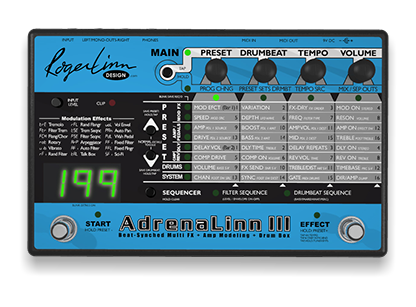This will cover the Adrenalinn III effects pedal, by Roger Linn designs. Since there’s so much to this thing, I’m going to break it up into sections. The first thing we’re going to look at is the built-in amp models.
Not only does this pedal have 40 different amp sounds (including bass amps), each one has (3) tone controls, plus drive and a drive “boost” control, so you can actually get a lot more than 40 sounds out of it. When you add in different pickup configurations, you can get almost unlimited tones out of it.
Here’s the list of amps (the RLD ones are from Roger Linn Design, not modeled off of a specific amp):
- Fender Bassman
- Fender Black Deluxe Reverb
- Fender Twin Reverb
- Fender Tweed Deluxe
- Fender Champ
- Marshall JTM-45
- Marshall ―Plexi‖ Super Lead 100
- Marshall JCM800
- Marshall JCM2000
- Vox AC30
- Vox AC15
- Roland Jazz Chorus
- Hiwatt DR103
- Mesa Boogie Mark II
- Mesa Boogie Dual Rectifier
- Soldano SLO-100
- Bogner Uberschall
- Diezel VH4
- ENGL Powerball
- Peavey 5150 MkII
- Bogner Ecstasy
- Budda Twinmaster
- Matchless Chieftain
- RLD Intense: Intense high-gain solo tone
- RLD Mid: high-gain mid-centric tone
- RLD Sizzle: Present high-end sizzle
- RLD Plexi:Marshall ―Plexi‖ from AdrenaLinn II
- RLD Scoop: High-gain amp with scooped mid
- RLD Crisp: ―Crisp‖ twangy tone
- RLD Hollow: Hollow tone
- RLD Bite: Upper-mid ―bite
- RLD Neck: Intense treble for neck pickup
- RLD Solid: ―Solid crunch tone
- Bass amp: Acoustic 360
- Bass amp: Ampeg SV T
- Bass amp: Gallien-Krueger 800RB
- Bass amp: SWR SM-500
- Distortion pedal: Fuzz Tone
- Distortion pedal: Octave Fuzz
- Clean mic preamp
My personal favorites are the Roland JC-120 (because I own a similar amp), the Vox AC30, the Fender Twin (great for twangy blues) and the Clean Preamp for acoustic guitar. If you own an overdrive pedal (who doesn’t nowadays?) you can stack it and change the amp’s character even more.
The biggest test for an amp modeler to pass is the playability test. Does it react to your playing? Does it sound natural, and not sterile/digital? Does it sound and react like the actual amp it’s pretending to be?
Obviously, there’s only so many of these I can test against the real thing. You can also set the pedal to “Direct” or “Amp” mode, which compensates for playing through an actual amp, or runs the EQ flat to go straight into a PA system. Here’s my demo of the amp models (forgive me, I forgot what some of the models were!) running straight into the audio interface, no amplifier. It’s a little boomy at first, but I get it sorted out.
[youtube_sc url=”https://www.youtube.com/watch?v=bxSLWa4YQLU”]
I think overall, the amp models sounds really good for what they are. The playability is definitely there, I can get some nice in-between sounds from most of the amps, and they do react to your playing attacks. It “feels” better playing through a large amp, because you get the physical feeling of the sound waved, but it sounds perfectly fine when running through a FOH sound system.
Next time we’ll get into some of the effects in this amazing little box.

